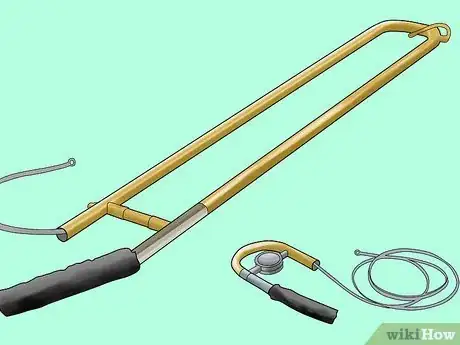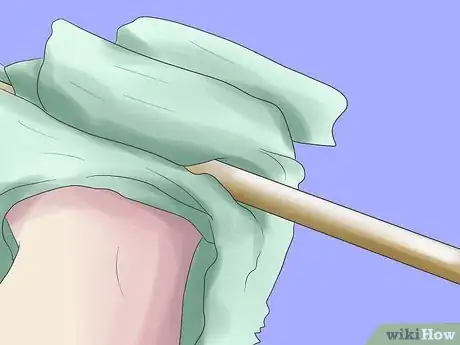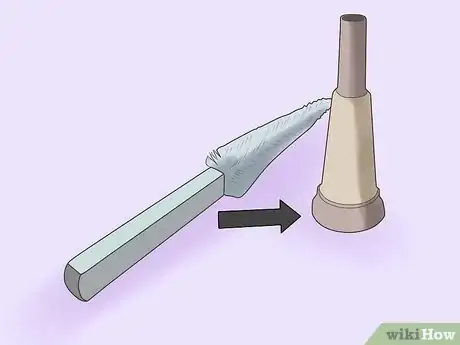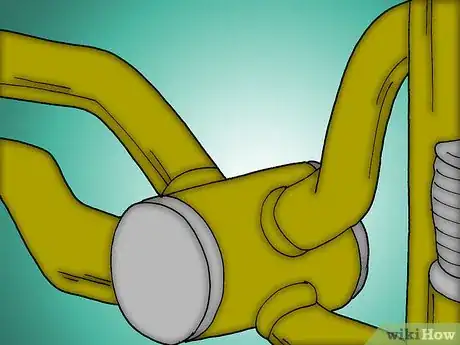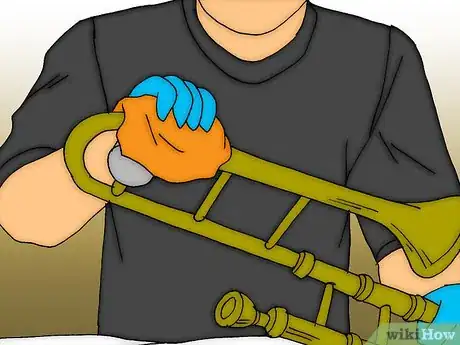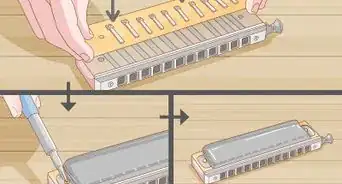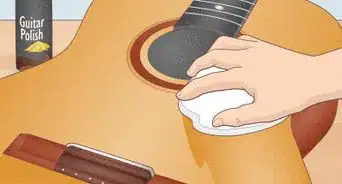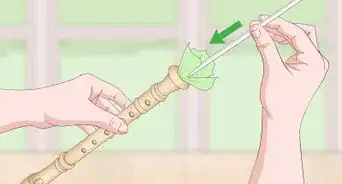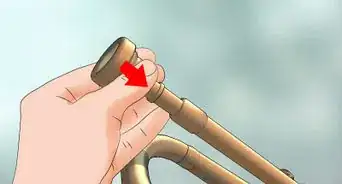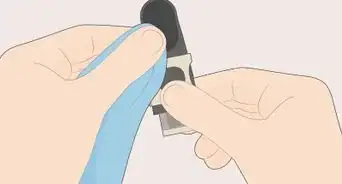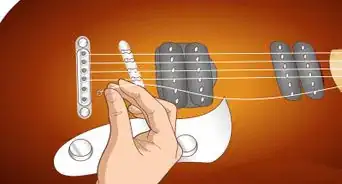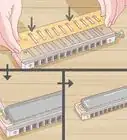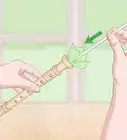wikiHow is a “wiki,” similar to Wikipedia, which means that many of our articles are co-written by multiple authors. To create this article, 28 people, some anonymous, worked to edit and improve it over time.
wikiHow marks an article as reader-approved once it receives enough positive feedback. In this case, 90% of readers who voted found the article helpful, earning it our reader-approved status.
This article has been viewed 140,246 times.
Learn more...
Trombone maintenance is a practice which should be a part of every trombonist’s daily playing routine. Keeping a clean instrument not only serves to maintain the value of your investment, but it also helps keep your slide and valve movements easy and smooth, allowing for more maneuverability with the instrument and better sound quality. Here are a few steps to follow when performing general maintenance on your trombone.
Things You Should Know
- Disassemble the trombone. To deep clean the instrument, soak the parts in lukewarm water. Otherwise, wipe down the parts with a soft rag.
- Use a cleaning rod or a “snake” to remove excess grease, oil, and moisture from the outer and inner slides.
- Dry off all components with a soft rag and reassemble your trombone. Apply lubricant as you normally would.
Steps
Using a Bathtub
-
1Fill a bathtub with lukewarm water. Do NOT use hot water. It helps to place a dampened towel or cloth at the bottom of the bathtub to avoid dents or scratches.
- Hot water can actually damage the lacquer. Lukewarm water will be just fine.
-
2Disassemble the trombone into its two main parts, the slide and the bell section. Next, take the outer slide off the inner slide. You should now have three parts. Then remove the tuning slide (or both if you have a Bb/F trigger trombone).
- Now you should have four (or five) parts in the water. Include the mouthpiece and you will have five (or six.)
Advertisement -
3Place all the parts in the bathtub of lukewarm water and let them soak. *Gently handle the parts at all times.[1]
-
4Once the parts have soaked for five to ten minutes, stand the bell section up away from the other parts and gently rub the bell with the cotton rags on the outside and as much as you can on the inside.
- Rinse the bell with cold water.
- Use the beach towel and dry the bell as much as possible. Set it aside in a safe place where it will not be knocked over and let it finish by air drying.
-
5Take the outer slide and run the snake back and forth through inside of it. Make sure the outer slide is filled with water. Do this for about 1 to 2 minutes on each side of the slide.
- Often junk will come out into the water. That's good! Keep working at it for at least a minute on each side. Using a clean stream of cold water, rinse the inside and outside of the outer slide. Dry with a beach towel and let it air dry with the bell.
-
6Pick up the inner slide and using a clean cotton rag, wipe it firmly but gently up and down the outside. Next, take the snake and clean the inside of the inner slide as before with the outer slide. Rinse and dry and place it with the other parts.[2]
-
7Use the snake to clean the inside of the tuning slide.[3]
- Often the tuning slide grease will eventually gum on the part of the tuning slide that fits into the bell section. To clean this, use a penetrating oil like WD-40. Spray the tuning slide with the penetrating oil and let it sit for a few minutes, before wiping away as much "gunk" as possible. If the horn has not been cleaned in a while, you may have to repeat this process several times.[4]
-
8Take the mouthpiece brush and push it back and forth into the shank (the part that fits into the trombone) of the mouthpiece. This will only take about 30 seconds or so. Rub the mouthpiece with a cotton rag, then dry it. If the mouthpiece gets gunk in the cup or shank, it will greatly disrupt the airflow when playing, so do not neglect your mouthpiece.[5]
-
9Finishing off.
- After the horn has completely "air dried" you will have a nice clean trombone. You will have to reapply a slide lubricant to the slide, then apply tuning slide grease to the tuning slides. Use both sparingly -- a little goes a long way.[6]
- Reinsert the tuning slide(s) into the bell section. Wipe any extra grease away with a clean cloth or cotton rag. Now your set to clean your trombone and remember clean well and clean often.
Using a Rag
-
1Disassemble the trombone by unscrewing the bell portion from the slide and removing the mouthpiece.
-
2Remove the outer slide and wipe off any excess grease, oil or moisture from the inner slides with a soft rag. Be careful not to bend or dent either slide in the process. Be gentle!
-
3Use a cleaning rod or a “snake” (a flexible rubber coated metal wire with a small brush on both ends), clean out any excess grease, oil or moisture from the insides of the outer and inner slides. If using a cleaning rod, be careful not to jam the rod into the bottom of the slide. If you are rough, you risk denting the crook at the end of the slide.
-
4Remove the main tuning slide from the bell portion and clean the inside with a “snake”.
-
5Do the same for F attachment tuning slide if your trombone has the F attachment.
-
6If absolutely necessary, disassemble the rotary valve for the F attachment, rinse off each piece and wipe off excess oil or grease. However, this stage of the cleaning should really be handled by a trained instrument technician, as any sort of scratch or dent in the valve will adversely affect the playability of the horn.
-
7Rinse all trombone components with warm water (NOT HOT, see warnings) in a shower or bath. Special attention should be given to the rotary valve, water key (or spit valve), and the outer and inner slides.
-
8Dry off all components with a soft rag, making sure that no large pockets of water remain in any of the tubing or in the rotary valve.
-
9Apply necessary grease to the tuning slides and attach them to the bell portion of the instrument.
-
10Reassemble the rotary valve and apply necessary oils. Most of the oil should be applied by dripping it in through the pipe where the bell section and playing slide meet, though a few drops may be applied to the rotary valve directly.
-
11Reassemble inner slide and outer slide and attach it to the bell section of the trombone.
-
12Apply necessary slide grease or oils to the inner slide.
-
13Wipe down the entire outside of the trombone using a soft rag.
Community Q&A
-
QuestionCan I use any spray bottle? A bottle didn't come in my cleaning kit and I was wondering if a small, cleaned, body mist bottle would be fine.
 Forte PianoCommunity AnswerAny bottle that has a sprayer on top will do fine. Just be sure to rinse it out first! A small, compact, portable bottle is preferred, though.
Forte PianoCommunity AnswerAny bottle that has a sprayer on top will do fine. Just be sure to rinse it out first! A small, compact, portable bottle is preferred, though. -
QuestionDo I have to use a snake?If you were going to clean the inside of the slide, a snake would be the easiest and safest way.
-
QuestionI use a cleaning rod for dry cleaning to clean my trombone, but the cloth part tears easily. Is there something else I can use? Like an old t-shirt?
 Community AnswerNEVER use a cleaning rod on the inside or outside of your trombone. It can scratch your instrument. You can use just the cleaning rod cloth for wiping away excess oil. You could use a t-shirt, too, but better yet is using water to avoid any possibility of scratching.
Community AnswerNEVER use a cleaning rod on the inside or outside of your trombone. It can scratch your instrument. You can use just the cleaning rod cloth for wiping away excess oil. You could use a t-shirt, too, but better yet is using water to avoid any possibility of scratching.
Warnings
- Do not use a blow dryer for any part of the drying process, as a blow dryer can get very hot and can damage the lacquer!⧼thumbs_response⧽
- Be very careful with the parts, especially the inner and outer slide.⧼thumbs_response⧽
- Do not use abrasive cleaners or cleaning pads, which will rub off the lacquer. In other words, do not use Ajax, Comet, Brasso, SOS pads, steel wool, etc.⧼thumbs_response⧽
- When washing the horn, do not use overly hot water. It can cause the lacquer to flake off allowing air to get to the raw brass. For horns that are not lacquered, be careful with the heat as brass is a very soft metal and too hot a temperature can actually cause the horn to warp.⧼thumbs_response⧽
- When handling any of the slides (though special care should be taken with the inner and outer playing slides), make sure that they are placed on a relatively soft, smooth surface when they are not being cleaned to avoid denting, as this could result in changes in the sound quality of the instrument or even render the instrument unusable.⧼thumbs_response⧽
- Be careful when using the main slide especially. If it hits something hard it may dent and bend rendering the instrument unplayable.⧼thumbs_response⧽
- If you do not know how to disassemble your F attachment rotary valve, simply leave it as it is and oil it whenever you conduct this maintenance. Mistakes in the assembly or disassemble of the valve may damage your instrument.⧼thumbs_response⧽
Things You'll Need
Using a Bathtub
- Flexible brush commonly called a "snake" which can be purchased at any music store
- Mouthpiece brush -- again available at any music store.
- Bathtub
- Mild soap. Some like to use horn soap (available at many music stores) but this is not necessary. Mild dish soap will be fine. Lemon or orange is even better.
- Some cotton rags (old t-shirts work best.)
- Beach towel to dry the trombone
Using a Rag
- Two soft rags—one for the cleaning of the instrument, one for the polishing of the instrument after the cleaning is done
- Cleaning rod and rag, or a “snake”
- Any slide grease or oil that you normally use
References
- ↑ https://www.youtube.com/watch?v=8LN7ZuVM3YE
- ↑ https://www.youtube.com/watch?v=0-5qYuIlrh0
- ↑ https://www.yamaha.com/en/musical_instrument_guide/trombone/maintenance/
- ↑ https://www.youtube.com/watch?v=kYXQhR999ss
- ↑ https://takelessons.com/blog/brass-instruments-mouthpiece-care/
- ↑ https://www.youtube.com/watch?v=tl_FbXeJAqc




